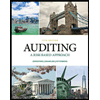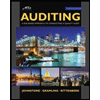
a.
Introduction: It is about the materiality as used in Accounting and Auditing To define: The Materiality as used in Accounting and Auditing, especially focusing the difference that lies between FASB and the US Supreme Court definitions of Materiality
b.
Introduction: It is about the three major dimensions of materiality.
To define: The Three major dimensions of Materiality 1) Dollar Magnitude 2) Nature of Item in consideration 3) View of a particular user.
c.
Introduction: It is about the change in the Materiality aspect during the course of audit.
To explain: The implication of changes in the Materiality aspects during Audit and the impact on the audit work already done till now.
Trending nowThis is a popular solution!

Chapter 7 Solutions
ACP AUDITING - RISK BASED APPROACH
- During its first year, Maple Corp. showed a $20 per-unit profit under absorption costing but would have reported a total profit of $18,000 less under variable costing. Suppose production exceeded sales by 600 units and an average contribution margin of 60% was maintained. a. What is the fixed cost per unit? b. What is the sales price per unit? c. What is the variable cost per unit? d. What is the unit sales volume if total profit under absorption costing was $220,000?arrow_forwardthe after-tax income?arrow_forwardPetron Pet Supplies sells on terms of 3/10, net 60. What is the effective annual cost of trade credit under these terms? Use a 365-day year. ANSWERarrow_forward
 Auditing: A Risk Based-Approach (MindTap Course L...AccountingISBN:9781337619455Author:Karla M Johnstone, Audrey A. Gramling, Larry E. RittenbergPublisher:Cengage Learning
Auditing: A Risk Based-Approach (MindTap Course L...AccountingISBN:9781337619455Author:Karla M Johnstone, Audrey A. Gramling, Larry E. RittenbergPublisher:Cengage Learning Auditing: A Risk Based-Approach to Conducting a Q...AccountingISBN:9781305080577Author:Karla M Johnstone, Audrey A. Gramling, Larry E. RittenbergPublisher:South-Western College Pub
Auditing: A Risk Based-Approach to Conducting a Q...AccountingISBN:9781305080577Author:Karla M Johnstone, Audrey A. Gramling, Larry E. RittenbergPublisher:South-Western College Pub


